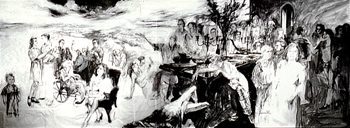CLOSE READING
PARTY OF 36 (PLUS 1 SERPENT)
by Steven Henry Madoff, The New York Times
One winter morning in 2001, the artist James Drake was sitting over coffee with the novelist Cormac McCarthy. They were at one of their regular haunts in Santa Fe, N.M., where they both live, chatting about work and family, the kinds of things said idly that lead to other thoughts.
“What I remember most,” Mr. Drake, 58, said recently, “is talking about the past. Maybe it was the shadow of 9/11 or just getting on toward 60, but I was thinking, ”Who are the really important people in my life?” You know, relatives, friends, the living and the dead who have influenced my art. And I said out loud that it would be interesting to make a picture like that, a banquet a gathering, like the old court painters made — Raphael”s “School of Athens,” Velazquez”s “Las Meninas” — something on a grand scale but modern and psychologically interesting, and that”s when I started planning the picture in my head.”
What emerged in obsessive fashion over the next two and a half years is “City of Tells,” an  epic 12 by 32 foot drawing in charcoal on paper that goes on view next weekend at the contemporary art center Site Santa Fe. (A companion video work shows feral pigs, a hummingbird, a rooster and a python devouring heaps of food on the same banquet table used for the drawing.)
epic 12 by 32 foot drawing in charcoal on paper that goes on view next weekend at the contemporary art center Site Santa Fe. (A companion video work shows feral pigs, a hummingbird, a rooster and a python devouring heaps of food on the same banquet table used for the drawing.)
Imagine your own dream party, with a guest list embracing the familiar and fantastic, past and present. Mr. Drake’s includes family members, and friends like Mr. McCarthy, the artist Bruce Nauman and the physicist and Nobel laureate Murray Gell-Mann, rubbing shoulders with Dante, Delacroix, Homer, Michelangelo Melville, Goya and Raphael. There are 37 figures in all,” including one biblical serpent; the floating legs of a drowned seaman; and the artist, far left, as a little boy.
“We live in such a fast-moving world that the past gets lost, and I think the strength of our culture is the memory of what’s good in it,” Mr. Drake said. “That’s what I wanted to honor. If we don’t carry the greater past with us, who are we?”
METHOD
Starting with a full-size study called a cartoon, Mr. Drake used photographs and historical images to create tracings of each figure. He moved them around, discarding some, then drew directly on a big paper sheet. An image of Alexander the Great, for example, was tried seven times but never made it into the final drawing. The artist used just four tools to create every textural effect, from flesh to glassy highlights: apiece of soft leather called achamois; paper towels, a kneadederaser and his five fingertips.
BABY JAMES
The artist wanted to insert his self-portrait, just as his hero, Raphael (who stands next to Goya, far right), did in “The School of Athens.” But Mr. Drake chose to show himself at age 21/2, his parents dancing nearby, “with all the innocence of childhood, with all the possibility of life going forward,” he said. Then, as a counterweight to innocence, he drew the fateful shake on the table, with its bowl of tempting fruit.
Mr. Drake saw Gericault”s “Raft of the Medusa” on his first trip to Europe, in 1972, and stopped dead in his tracks. “I didn’t think I could do anything to equal that, and I never painted again — I just started drawing,” Mr. Drake said. Framed by the table, a drowned sailors leg from the Gericault painting, a high-heeled shoe and Bruce Nauman’s boot jointly form a brightly lighted picture within the picture, anchoring the drawing.
THE MISTRESS
Ripe with allusions, “The City of Tells” turns on the lounging figure of La Malinche, who was Cortes”s mistress during his conquest of Mexico. “Historians say she was just as smart and powerful as he was, so I made her muscular and androgynous,” Mr. Drake said. Her languid pose echoes Goya”s famous etching “The Sleep of Reason Begets Monsters” (Goya himself appears at the far right of the picture). And her ornate tattoos? A nod to Diego Riveras portrait of her. Rivera, bare belly exposed, stands next to Dante at the left side of the picture, shooting a glance at the viewer.
THE TELLS
In gambling, a “tell” is the way a player unconsciously reveals his hand in a gesture or a look. Mr. Drake s crowd of faces reveals each figure s character, while their gestures help to tie the composition together. Look at the expressive forms, starting at far right, where his daughter lays a kind hand on a shoulder; then the sinister snake; the sculptor John Torreanos generous raised palm; and the robed Dante at the left, with his arm lifted in fear or surprise.
COMPOSITION
“Murray once wrote something like, ”All I need is a pencil and a piece of paper and I can explore the universe/ That’s all I need, too, to draw my own little piece of the universe,” Mr. Drake said. Murray Gell-Mann, near the arched doorway, is at the end of a straight visual line that shoots from the dead sailors legs and forms a big V with the primal landscape, creating a sweeping illusion of space and time, from the beginning of the world to the present.

